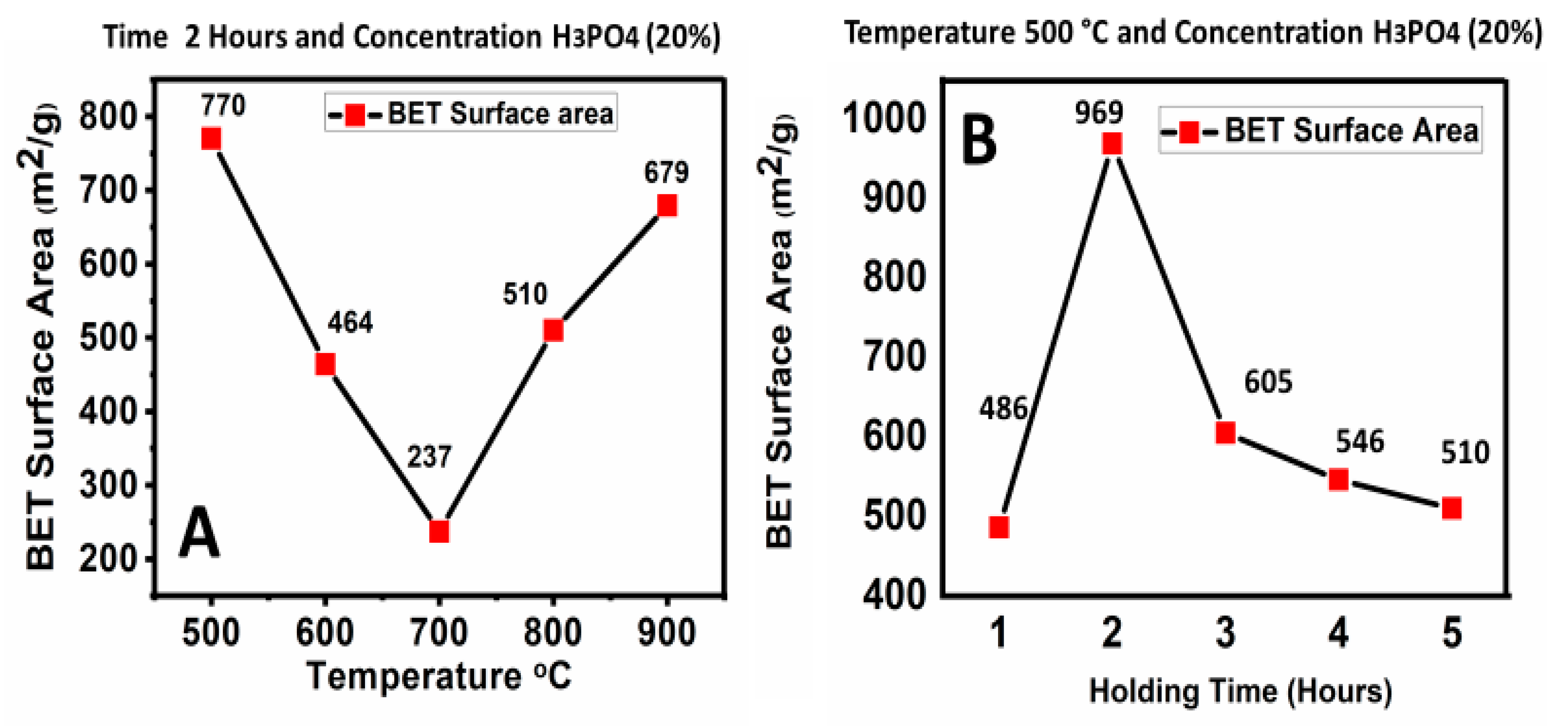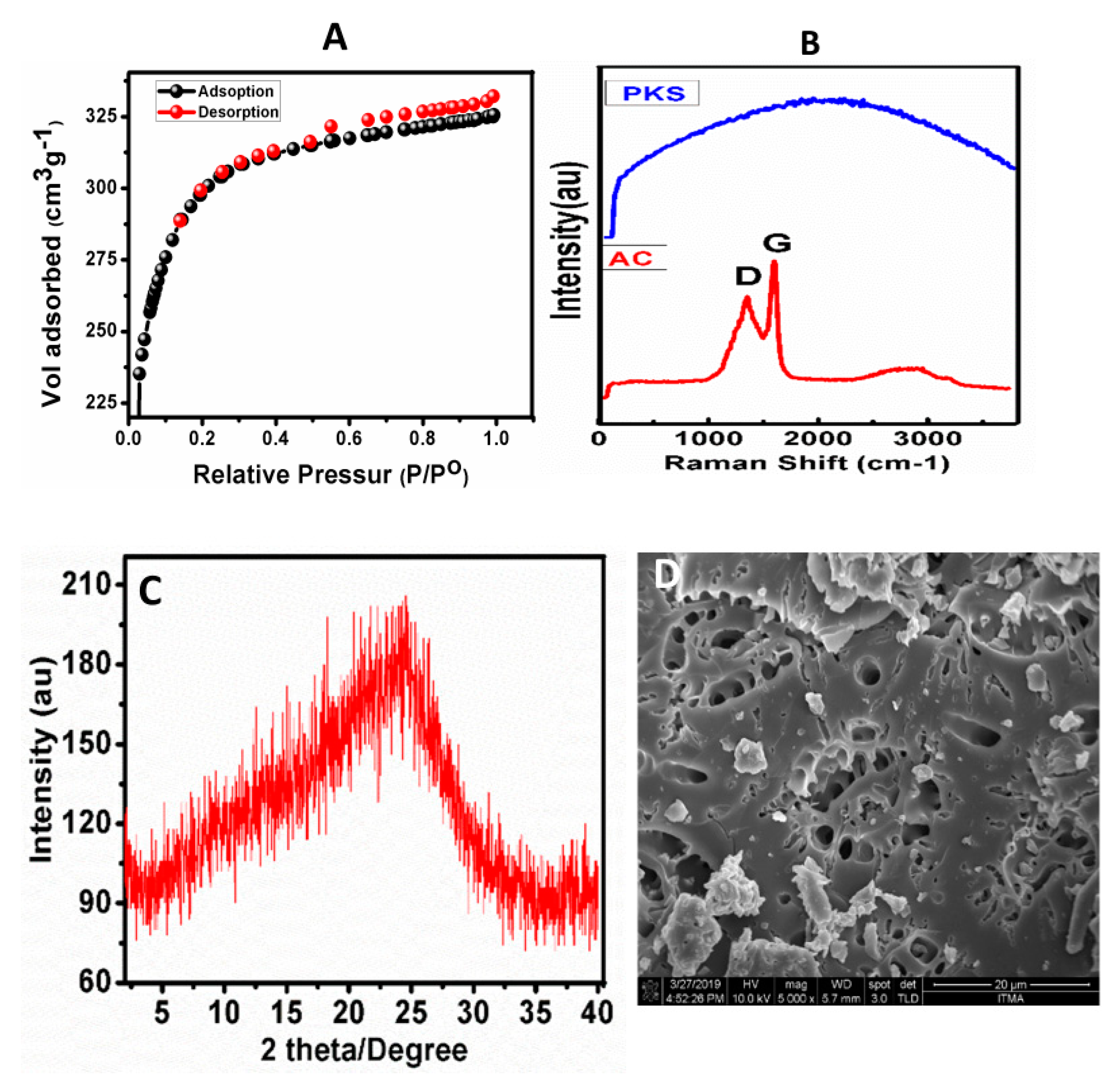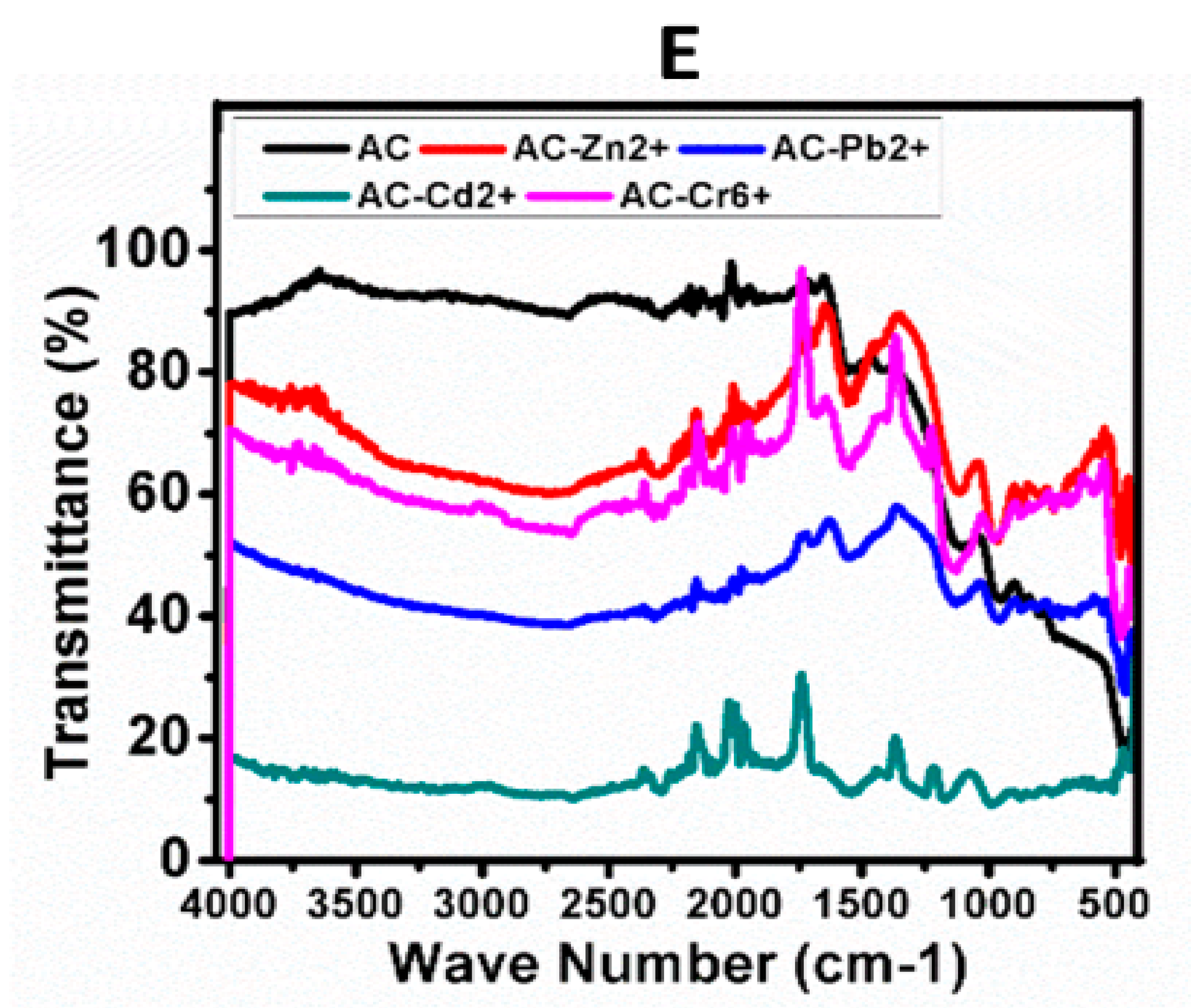Ecofriendly Approach for Treatment of Heavy-Metal-Contaminated Water Using Activated Carbon of Kernel Shell of Oil Palm
Abstract
1. Introduction
2. Materials and Methods
2.1. Chemicals
2.2. Pretreatment of and Activation of Sample
2.3. Effect of Temperature, Holding Time and H3PO4 Concentration on the Carbonization
2.4. Instrumentation
2.5. Characterization
3. Results and Discussion
3.1. Surface Area and Porosity
3.2. Adsorption and Desorption Isotherms
3.3. Raman Spectroscopic Analysis
3.4. X-ray Diffraction and FESEM Analysis
3.5. Infrared Spectroscopic Analysis
3.6. Batch Studies
3.7. Concentration Effect
3.8. Time Effect
4. Adsorption Kinetics
4.1. Isotherms Models of Adsorption
4.2. Adsorption Capacity
4.3. Comparison of PKS-Derived Activated Carbon Material with Other Carbonaceous Materials
5. Conclusions
Supplementary Materials
Author Contributions
Funding
Conflicts of Interest
References
- Baby, R.; Saifullah, B.; Hussein, M.Z. Palm Kernel Shell as an effective adsorbent for the treatment of heavy metal contaminated water. Sci. Rep. 2019, 9, 1–11. [Google Scholar] [CrossRef] [PubMed]
- Bansal, N. Industrial Development and Challenges of Water Pollution in Coastal Areas: The Case of Surat, India. IOP Conf. Ser. Earth Environ. Sci. 2018, 120, 012001. [Google Scholar] [CrossRef]
- UN-Water Global Analysis and Assessment of Sanitation and Drinking-Water (GLAAS) 2019 Report; World Health Organization: Geneva, Switzerland, 2019.
- Nakamura, T.; Hamasaki, M.; Yoshitomi, H.; Ishibashi, T.; Yoshiyama, C.; Maeda, E.; Sera, N.; Yoshida, H. Environmental surveillance of poliovirus in sewage water around the introduction period for inactivated polio vaccine in Japan. Appl. Environ. Microbiol. 2015, 81, 1859–1864. [Google Scholar] [CrossRef]
- Lu, X.; He, J.; Jing, R.; Tao, P.; Nie, R.; Zhou, D.; Xia, Q. Microwave-activated Ni/carbon catalysts for highly selective hydrogenation of nitrobenzene to cyclohexylamine. Sci. Rep. 2017, 7, 2676. [Google Scholar] [CrossRef] [PubMed]
- Baby Shaikh, R.; Saifullah, B.; Rehman, F.U. Greener Method for the Removal of Toxic Metal Ions from the Wastewater by Application of Agricultural Waste as an Adsorbent. Water 2018, 10, 1316. [Google Scholar] [CrossRef]
- Ahmed, M.; Ozaki, A.; Thinh, N.V.; Kurosawa, K. Heavy Metal Contamination of Irrigation Water, Soil, and Vegetables and the Difference between Dry and Wet Seasons Near a Multi-Industry Zone in Bangladesh. Water 2019, 11, 583. [Google Scholar] [CrossRef]
- Bhuyan, M.S.; Bakar, M.A.; Rashed-Un-Nabi, M.; Senapathi, V.; Chung, S.Y.; Islam, M.S. Monitoring and assessment of heavy metal contamination in surface water and sediment of the Old Brahmaputra River, Bangladesh. Appl. Water Sci. 2019, 9, 125. [Google Scholar] [CrossRef]
- Wei, J.; Duan, M.; Li, Y.; Nwankwegu, A.S.; Ji, Y.; Zhang, J. Concentration and pollution assessment of heavy metals within surface sediments of the Raohe Basin, China. Sci. Rep. 2019, 9, 1–7. [Google Scholar] [CrossRef]
- Pan, X.-D.; Wu, P.-G.; Jiang, X.-G. Levels and potential health risk of heavy metals in marketed vegetables in Zhejiang, China. Sci. Rep. 2016, 6, 1–7. [Google Scholar] [CrossRef] [PubMed]
- Cooper, A.M.; Felix, D.; Alcantara, F.; Zaslavsky, I.; Work, A.; Watson, P.L.; Pezzoli, K.; Yu, Q.; Zhu, D.; Scavo, A.J.; et al. Monitoring and mitigation of toxic heavy metals and arsenic accumulation in food crops: A case study of an urban community garden. Plant Direct 2020, 4, e00198. [Google Scholar] [CrossRef]
- Manzoor, J.; Sharma, M.; Wani, K.A. Heavy metals in vegetables and their impact on the nutrient quality of vegetables: A review. J. Plant Nutr. 2018, 41, 1744–1763. [Google Scholar] [CrossRef]
- Gebeyehu, H.R.; Bayissa, L.D. Levels of heavy metals in soil and vegetables and associated health risks in Mojo area, Ethiopia. PLoS ONE 2020, 15, e0227883. [Google Scholar] [CrossRef] [PubMed]
- Baby, R.; Saifullah, B.; Hussein, M.Z. Carbon Nanomaterials for the Treatment of Heavy Metal-Contaminated Water and Environmental Remediation. Nanoscale Res. Lett. 2019, 14, 341. [Google Scholar] [CrossRef]
- Ahmed, M.J. Application of agricultural-based activated carbons by microwave and conventional activations for basic dye adsorption. J. Environ. Chem. Eng. 2016, 4, 89–99. [Google Scholar] [CrossRef]
- Hegazy, A.K.; Abdel-Ghani, N.T.; El-Chaghaby, G.A. Adsorption of phenol onto activated carbon from Rhazya stricta: Determination of the optimal experimental parameters using factorial design. Appl. Water Sci. 2014, 4, 273–281. [Google Scholar] [CrossRef]
- Lazzarini, A.; Piovano, A.; Pellegrini, R.; Agostini, G.; Rudić, S.; Lamberti, C.; Groppo, E. Graphitization of Activated Carbons: A Molecular-level Investigation by INS, DRIFT, XRD and Raman Techniques. Phys. Procedia 2016, 85, 20–26. [Google Scholar] [CrossRef]
- Nicholas, A.F.; Hussein, M.Z.; Zainal, Z.; Khadiran, T. Palm Kernel Shell Activated Carbon as an Inorganic Framework for Shape-Stabilized Phase Change Material. Nanomaterials 2018, 8, 689. [Google Scholar] [CrossRef]
- Özsin, G.; Kılıç, M.; Apaydın-Varol, E.; Pütün, A.E. Chemically activated carbon production from agricultural waste of chickpea and its application for heavy metal adsorption: Equilibrium, kinetic, and thermodynamic studies. Appl. Water Sci. 2019, 9, 56. [Google Scholar] [CrossRef]
- Zhong, Q.; Jin, M. Nanoscalar Structures of Spray-Dried Zein Microcapsules and in Vitro Release Kinetics of the Encapsulated Lysozyme As Affected by Formulations. J. Agric. Food Chem. 2009, 57, 3886–3894. [Google Scholar] [CrossRef]
- Loh, K.P.; Ho, D.; Chiu, G.N.C.; Leong, D.T.; Pastorin, G.; Chow, E.K.-H. Clinical Applications of Carbon Nanomaterials in Diagnostics and Therapy. Adv. Mater. 2018, 30, 1802368. [Google Scholar] [CrossRef]
- Rauti, R.; Musto, M.; Bosi, S.; Prato, M.; Ballerini, L. Properties and behavior of carbon nanomaterials when interfacing neuronal cells: How far have we come? Carbon 2019, 143, 430–446. [Google Scholar] [CrossRef]
- Zaytseva, O.; Neumann, G. Carbon nanomaterials: Production, impact on plant development, agricultural and environmental applications. Chem. Biol. Technol. Agric. 2016, 3, 17. [Google Scholar] [CrossRef]
- Hernández-Monje, D.; Giraldo, L.; Moreno-Piraján, J.C. Study of Hexane Adsorption on Activated Carbons with Differences in Their Surface Chemistry. Molecules 2018, 23, 476. [Google Scholar] [CrossRef] [PubMed]
- Ayawei, N.; Ebelegi, A.N.; Wankasi, D. Modelling and Interpretation of Adsorption Isotherms. J. Chem. 2017, 2017, 1. [Google Scholar] [CrossRef]
- Chen, C.-J.; Zhu, W.; Chao, J.-H.; Shang, A.; Lee, Y.G.; Liu, R.; Yin, S.; Dubinskii, M.; Hoffman, R.C. Study of thermal and spatial dependent electric field-induced phase transition in relaxor ferroelectric crystals using Raman spectroscopy. J. Alloy Compd. 2019, 804, 35–41. [Google Scholar] [CrossRef]
- Pego, M.F.F.; Bianchi, M.L.; Carvalho, J.A.; Veiga, T.R.L.A. Surface modification of activated carbon by corona treatment. An. Acad. Bras. Ciências 2019, 91, 1. [Google Scholar] [CrossRef]
- Liu, X.; Xu, X.; Dong, X.; Park, J. Competitive Adsorption of Heavy Metal Ions from Aqueous Solutions onto Activated Carbon and Agricultural Waste Materials. Pol. J. Environ. Stud. 2020, 29, 749–761. [Google Scholar] [CrossRef]
- Mustapha, S.; Shuaib, D.T.; Ndamitso, M.M.; Etsuyankpa, M.B.; Sumaila, A.; Mohammed, U.M.; Nasirudeen, M.B. Adsorption isotherm, kinetic and thermodynamic studies for the removal of Pb(II), Cd(II), Zn(II) and Cu(II) ions from aqueous solutions using Albizia lebbeck pods. Appl. Water Sci. 2019, 9, 142. [Google Scholar] [CrossRef]
- Simonin, J.-P. On the comparison of pseudo-first order and pseudo-second order rate laws in the modeling of adsorption kinetics. Chem. Eng. J. 2016, 300, 254–263. [Google Scholar] [CrossRef]
- Hasan, S.; Al Ali, H.; Al-Qubaisi, M.; Zobir Hussein, M.; Ismail, M.; Zainal, Z.; Nazrul Hakim, M. Controlled-release formulation of antihistamine based on cetirizine zinc-layered hydroxide nanocomposites and its effect on histamine release from basophilic leukemia (RBL-2H3) cells. Int. J. Nanomed. 2012, 7, 3351–3363. [Google Scholar]
- Ho, Y.S.; Ofomaja, A.E. Pseudo-second-order model for lead ion sorption from aqueous solutions onto palm kernel fiber. J. Hazard. Mater. 2006, 129, 137–142. [Google Scholar] [CrossRef]
- Ammari, A.; Schroen, K. Flavor Retention and Release from Beverages: A Kinetic and Thermodynamic Perspective. J. Agric. Food Chem. 2018, 66, 9869–9881. [Google Scholar] [CrossRef]
- Redman, Z.C.; Tran, K.H.; Parikh, S.J.; Tjeerdema, R.S. Influence of pH and Divalent Metals Relevant to California Rice Fields on the Hydroxide-Mediated Hydrolysis of the Insecticide Chlorantraniliprole. J. Agric. Food Chem. 2019, 67, 12402–12407. [Google Scholar] [CrossRef]
- Farghali, A.A.; Abdel Tawab, H.A.; Abdel Moaty, S.A.; Khaled, R. Functionalization of acidified multi-walled carbon nanotubes for removal of heavy metals in aqueous solutions. J. Nanostruct. Chem. 2017, 7, 101–111. [Google Scholar] [CrossRef]
- Yang, S.; Li, J.; Shao, D.; Hu, J.; Wang, X. Adsorption of Ni(II) on oxidized multi-walled carbon nanotubes: Effect of contact time, pH, foreign ions and PAA. J. Hazard. Mater. 2009, 166, 109–116. [Google Scholar] [CrossRef]
- Xia, K.; Zhan, H.; Gu, Y. Graphene and Carbon Nanotube Hybrid Structure: A Review. Procedia IUTAM 2017, 21, 94–101. [Google Scholar] [CrossRef]
- Gupta, S.; Bhatiya, D.; Murthy, C.M. Metal Removal Studies by Composite Membrane of Polysulfone and Functionalized Single-Walled Carbon Nanotubes. Sep. Sci. Technol. 2015, 50, 421–429. [Google Scholar] [CrossRef]
- Alekseeva, O.V.; Bagrovskaya, N.A.; Noskov, A.V. Sorption of heavy metal ions by fullerene and polystyrene/fullerene film compositions. Prot. Met. Phys. Chem. Surf. 2016, 52, 443–447. [Google Scholar] [CrossRef]
- Zhang, C.-Z.; Chen, B.; Bai, Y.; Xie, J. A new functionalized reduced graphene oxide adsorbent for removing heavy metal ions in water via coordination and ion exchange. Sep. Sci. Technol. 2018, 53, 2896–2905. [Google Scholar] [CrossRef]
- Zheng, S.; Hao, L.; Zhang, L.; Wang, K.; Zheng, W.; Wang, X.; Zhou, X.; Li, W.; Zhang, L. Tea Polyphenols Functionalized and Reduced Graphene Oxide-ZnO Composites for Selective Pb2+ Removal and Enhanced Antibacterial Activity. J. Biomed. Nanotechnol. 2018, 14, 1263–1276. [Google Scholar] [CrossRef]
- Mousavi, S.M.; Hashemi, S.A.; Amani, A.M.; Esmaeili, H.; Ghasemi, Y.; Babapoor, A.; Mojoudi, F.; Arjomand, O. Pb(II) Removal from Synthetic Wastewater Using Kombucha Scoby and Graphene Oxide/Fe3O4. Phys. Chem. Res. 2018, 6, 759–771. [Google Scholar]
- Awad, F.S.; AbouZied, K.M.; Abou El-Maaty, W.M.; El-Wakil, A.M.; Samy El-Shall, M. Effective removal of mercury(II) from aqueous solutions by chemically modified graphene oxide nanosheets. Arab. J. Chem. 2018, 13, 2659. [Google Scholar] [CrossRef]
- Abeer El-Saharty, S.N.M.; Ahmed, H.M.; Adel Abdel, H.N.; Abdel, M.A. Effect of Apricot Stone Activated Carbon Adsorbent on the Removal of Toxic Heavy Metals Ions from Aqueous Solutions. Int. J. Ecotoxicol. Ecobiol. 2018, 3, 13. [Google Scholar] [CrossRef]
- Ibrahim, U.S.; Shamsul, R.M.K.; Ismail, A.F. Copper Metal Removal using Sludge Activated Carbon Derived from Wastewater Treatment Sludge. In MATEC Web of Conferences; Elsevier: Kuala Lumpur, Malaysia, 2018; Volume 203, p. 03009. [Google Scholar]
- Li, J.; Xing, X.; Li, J.; Shi, M.; Lin, A.; Xu, C.; Zheng, J.; Li, R. Preparation of thiol-functionalized activated carbon from sewage sludge with coal blending for heavy metal removal from contaminated water. Environ. Pollut. 2018, 234, 677–683. [Google Scholar] [CrossRef] [PubMed]
- Cao, F.; Lian, C.; Yu, J.; Yang, H.; Lin, S. Study on the adsorption performance and competitive mechanism for heavy metal contaminants removal using novel multi-pore activated carbons derived from recyclable long-root Eichhornia crassipes. Bioresour. Technol. 2019, 276, 211–218. [Google Scholar] [CrossRef]
- Dong, L.; Hou, L.A.; Wang, Z.; Gu, P.; Chen, G.; Jiang, R. A new function of spent activated carbon in BAC process: Removing heavy metals by ion exchange mechanism. J. Hazard. Mater. 2018, 359, 76–84. [Google Scholar] [CrossRef]
- Tlili, M.B. Removal of heavy metals from wastewater using infiltration-percolation process and adsorption on activated carbon. Int. J. Environ. Sci. Technol. 2019, 16, 249–258. [Google Scholar]
- Mohammad Hadi Dehghani, M.M.T.; Anil, K.B.; Behzad, H.; Inderjeet, T.; Mohammad, A.; Shilpi, A.; Vinod, K.G. Removal of noxious Cr (VI) ions using single-walled carbon nanotubes and multi-walled carbon nanotubes. Chem. Eng. J. 2015, 279, 344–352. [Google Scholar] [CrossRef]
- Ahmed, A.; Moosa, A.M.R.; Ibtihal, N.A. Chromium Ions Removal from Wastewater Using Carbon Nanotubes. Int. J. Innov. Res. Sci. Eng. Technol. 2015, 4, 8. [Google Scholar]
- Gupta, V.K.; Agarwal, S.; Saleh, T.A. Synthesis and characterization of alumina-coated carbon nanotubes and their application for lead removal. J. Hazard. Mater. 2011, 185, 17–23. [Google Scholar] [CrossRef]
- Tabish, T.A.; Memon, F.A.; Gomez, D.E.; Horsell, D.W.; Zhang, S. A facile synthesis of porous graphene for efficient water and wastewater treatment. Sci. Rep. 2018, 8, 1817. [Google Scholar] [CrossRef] [PubMed]
- Guo, T.; Bulin, C.; Li, B.; Zhao, Z.; Yu, H.; Sun, H.; Ge, X.; Xing, R.; Zhang, B. Efficient removal of aqueous Pb(II) using partially reduced graphene oxide-Fe3O4. Adsorpt. Sci. Technol. 2018, 36, 1031–1048. [Google Scholar] [CrossRef]






| Assignment | AC | AC-Cr6+ | AC-Cd2+ | AC-Pb2+ | AC-Zn2+ |
|---|---|---|---|---|---|
| V (O-H) | 2658 | 2651 | 2639 | 2600 | 2610 |
| C=C (aromatic) | 1687 | 1683 | 1697 | 1699 | 1728 |
| 1554 | 1544 | 1531 | 1552 | 1556 | |
| 1418 | 1401 | 1392 | 1395 | 1393 | |
| CH2/CH3 (sym) | 1205 | 1241 | 1249 | 1232 | 1235 |
| 1104 | 1126 | 1176 | 1143 | 1119 | |
| C–O (stretching) | 951 | 980 | 988 | 963 | 964 |
| C–C (stretching) | 878 | 878 | 874 | 874 | 874 |
| 788 | 801 | 812 | 797 | 792 | |
| 735 | 739 | 743 | 735 | 735 |
| Metal Ion | Langmuir Isotherm | Freundlich Isotherm | ||||
|---|---|---|---|---|---|---|
| qe (mg/g) | b (L/mg) | R2 | Kf | nf | R2 | |
| Cr 6+ | 50.76 | 0.010 | 0.9808 | 0.34 | 0.664 | 0.9920 |
| Pb2+ | 50.80 | 0.001 | 0.9548 | 1.00 | 0.306 | 0.9993 |
| Cd2+ | 47.01 | 0.101 | 0.4047 | 1.00 | 0.301 | 0.9999 |
| Zn2+ | 45.34 | 0.016 | 0.9399 | 1.00 | 0.301 | 0.9999 |
| No. | Adsorbent | Metal Ions | Contact Time in h | Optimum pH for Adsorption | Adsorption Capacity (mg/g)/Efficiency (%) | Reference |
|---|---|---|---|---|---|---|
| 1 | AC (20% H3PO4) | Cr6+ Pb2+ Cd2+ Zn2+ | 2 | 6 | 99% 99% 80% 80% | Rabia et al. (This study) |
| 2 | SWCNTs | Cr6+ | 1.00 | 2.5 | 2.35 mg/g | Dehghani et al., 2015 [50] |
| 3 | MWCNTs | Cr6+ | 1.00 | 2.5 | 1.26 mg/g | Dehghani et al., 2015 [50] |
| 4 | Functionalized MWCNTs | Pb2+ Ni2+ Cu2+ Cd2+ | 6.00 | 9.0 | 93% 83% 78% 15% | Farghali et al., 2017 [35] |
| 5 | Functionalized MWCNTs | Cr3+ | 3.00 | 6.0 | 99.83% | Ahmad et al., 2015 [51] |
| 6 | Al2O3-MWCNTs | Pb2+ | 1.00 | 7.0 | 90% | Gupta et al. 2011 [52] |
| 7 | Porous graphene | As 3+ | 1.00 | 7.0 | 90% | Tabish et al., 2018 [53] |
| 8 | rGO-Fe3O4 | Pb2+ | 0.16 | 6.0 | 373.14 mg/g | Guo et al., 2018. [54] |
| 9 | (reduced GO-Sulfophenylazo (rGOS) | Pb2+ Cu2+ Ni2+ Cd2+ Cr3+ | 0.16 | 5.0 | 689 mg/g 59 mg/g 66 mg/g 267 mg/g 191 mg/g | Zhang et al., 2018 [40] |
© 2020 by the authors. Licensee MDPI, Basel, Switzerland. This article is an open access article distributed under the terms and conditions of the Creative Commons Attribution (CC BY) license (http://creativecommons.org/licenses/by/4.0/).
Share and Cite
Baby, R.; Hussein, M.Z. Ecofriendly Approach for Treatment of Heavy-Metal-Contaminated Water Using Activated Carbon of Kernel Shell of Oil Palm. Materials 2020, 13, 2627. https://doi.org/10.3390/ma13112627
Baby R, Hussein MZ. Ecofriendly Approach for Treatment of Heavy-Metal-Contaminated Water Using Activated Carbon of Kernel Shell of Oil Palm. Materials. 2020; 13(11):2627. https://doi.org/10.3390/ma13112627
Chicago/Turabian StyleBaby, Rabia, and Mohd Zobir Hussein. 2020. "Ecofriendly Approach for Treatment of Heavy-Metal-Contaminated Water Using Activated Carbon of Kernel Shell of Oil Palm" Materials 13, no. 11: 2627. https://doi.org/10.3390/ma13112627
APA StyleBaby, R., & Hussein, M. Z. (2020). Ecofriendly Approach for Treatment of Heavy-Metal-Contaminated Water Using Activated Carbon of Kernel Shell of Oil Palm. Materials, 13(11), 2627. https://doi.org/10.3390/ma13112627





